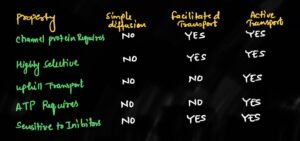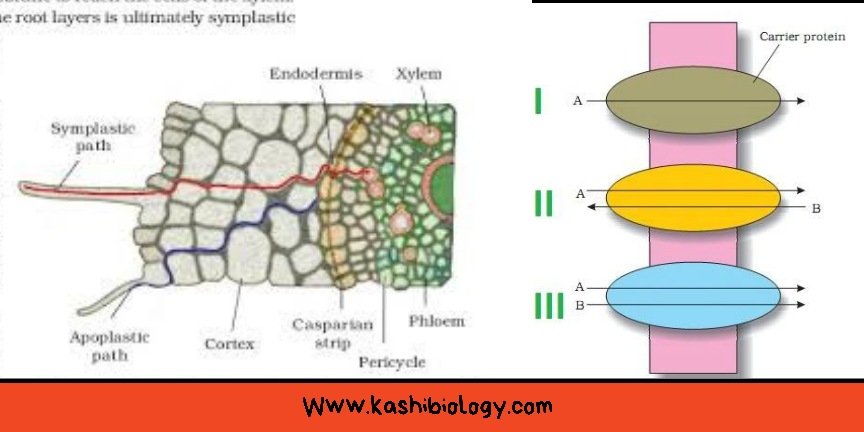Hello welcome to kashibiology. We have almost completed most of the topics on human biology on our website ,today we are going to discuss about some topics Plant biology. Like Transport in Plants. Plant transport happen with the help of two types tissues i.e Xylem and Phloem . So lets get into this topic and find out more details .
Modes of Local Transport in the Plants
In the previous post we have learnt about what is transport?
In this post we will learn about- what are the different modes of molecules movements involved in short distance transport.
In which modes of transport, energy is needed for the movement of molecules.
Actually short distance transport of molecules involves Cell to cell movement or cell to nearby cells/tissues movement.
Even Movement of different chemicals within the cell by Cytoplasmic Streaming is also the short distance transport of chemicals.
Modes of short distance transport-
There are two modes of short distance transport that is passive transport and active transport
Passive transport involves the movement of molecules from the region of their higher concentration to the region of lower concentration without the use of energy.
While in active transport the process takes place movement of molecules from the lower to higher concentration with the use of energy provided by ATP molecules.
Types of passive transport
As the name passive indicates that, there is no involvement of ATP molecules.
It is classified into different types in different categories
Simple Diffusion
The movement of molecules of gases or liquids from the region of their higher concentration to the region of their lower concentration is called diffusion.
It is noted that diffusion not always occurs in the living system but diffusion also occurs in non living systems.
For example-
When we burnt the smell stick at the corner of the room, later the smell sprayed in the whole room. This is due to the diffusion of molecules in the gaseous stage.
The movement of molecules takes place till the equilibrium reaches on the two sides of the system.
Most of the neutral or nonpolar and water molecules are transported in short distances due to the diffusion.
What are the factors affecting the process of diffusion?
High temperatures increase the movement of molecules.
The concentration gradient of transported molecules on the two sides
Lipids soluble particles move faster than the lipids in soluble molecules.
In the living system the surface area also plays an important role in the movement of molecules during diffusion.
Increase in pressure also increases the movement of molecules.
Permeability of plasma membrane is also an important factor during diffusion in the living System.

What is Facilitated diffusion?
It is the movement of polar molecules from the region of their higher concentration to the region of their lower concentration with the help of some channel or carrier protein without use of ATP.
Such a type of movement of polar molecules is called facilitated diffusion.
In facilitated diffusion the molecules which are not transport by lipids membrane, that is they are lipophobic but hydrophilic in nature.
Hence cannot easily cross the plasma membrane lipids bilayer.
Therefore they need some special type of proteins called carrier protein or Transport protein or channel protein.
These proteins are present in the plasma membrane of the cell, and they facilitate the diffusion of polar molecules.
Hence it is called facilitated diffusion. however the transport or channel proteins are sensitive to inhibitors.
Any chemicals which can disturb the structure and function of these channel or transported proteins also disturb the process of facilitated diffusion.
Because these inhibitor substances can react with the side chain of protein.
These inhibitory substances may be toxins of internal origin or enter the external environment.
These protein channels are different types- some are always open while some are controlled.
that is they open when transported molecules bind to them.

Some are forming large pores, which allow a variety of large molecules to cross the membrane.
Similar types of protein channels are found in the outer membrane of Plastids, Mitochondria and Bacteria are form huge pores. These are called Porin.
Similarly water channels for movement of water transport and consists of eight different types of Aquaporins protein molecules.
What is Cotransport and Uniport?
In facilitated diffusion some of the transport protein or carrier Proteins transports molecules in the following manner.
Uniport-
When a chemical molecule or ions move across the plasma membrane independent of other chemical molecules then such a process is called Uniport.
Cotransport-
In this two different types of molecules move across the membrane. it is of following types-
Symport:
In this both the molecules cross the plasma membrane in the same direction.
that is from cytoplasm to the external of the cell or vice versa but the direction of movement of both the molecules is the same.
Antiport:
In this transport both the molecules move across the plasma membrane in opposite directions.
that is one more from external to the internal of the cell and other from internal to the external of the cell.
What is Independent Diffusion?
When movements of a chemical molecule are individually moved according to their concentration gradients without related to the concentration gradient of another molecule this is called independent diffusion.
Hence the Diffusion of one particle of one substance is independent of the diffusion of particles of other substances is called independent diffusion.
What is Osmosis?
The movement of water or solvent molecules from the region of their higher concentration to the region of their lower concentration with the help of a semipermeable membrane is called osmosis.
The process of osmosis and their different aspects will be discussed in the coming post in very detail, here only we shall learn only about its definition.
What is Active Transport?
The movement of molecules from the region of their lower concentration to the region of their higher concentration with the help of protein channels and the use of energy provided by ATP molecules is called active transport.
It is the uphill transport and also sensitive to the inhibitory molecules.
Comparison between different types of transport mechanisms in the living system as shown in the diagram.
Difference between Passive and Active Transport-
Passive transport: The key points are
Downhill transport
No use of ATP
Low to High concentration
With concentration gradient
Active transport: The key points are
Uphill transport
Use of ATP
Higher concentration to lower concentration
Against concentration gradient
Conclusion
So the short distance Conduction of molecules in plants follow some basic modes of transport mechanism.
In which some use energy while others are not.
As well as some is the downhill transport while the uphill transport.
Hope you will like this post. If you have any mistakes or advice from your side please comment us. We shall try to update in post.
Thanks for your valuable time for reading this article.
Hope your online journey is going well.

